|
|
|
|
 |
CARNIVORES: Bobcats |
|
|

Identification
The bobcat (Lynx rufus),
alias “wildcat,” is a medium-sized member of the North
American cat family. It can be distinguished at a
distance by its graceful catlike movements, short (4- to
6-inches [10- to 15-cm]) “bobbed” tail, and round face
and pointed ears (Fig. 1). Visible at close distances
are black hair at the tip of the tail and prominent
white dots on the upper side of the ears. Body hair
color varies, but the animal’s sides and flanks are
usually brownish black or reddish brown with either
distinct or faint black spots. The back is commonly
brownish yellow with a dark line down the middle. The
chest and outside of the legs are covered with brownish
to light gray fur with black spots or bars. Bobcats
living at high elevations and in northern states and
Canada have relatively long hair. In southern states,
bobcats may have a yellowish or reddish cast on their
backs and necks.
Similar Species. The bobcat is two to three
times the size of the domestic cat and appears more
muscular and fuller in the body. Also, the bobcat’s hind
legs are proportionately longer to its front legs than
those of the domestic cat. The Canada lynx appears more
slender and has proportionately larger feet than the
bobcat. At close distances, the ear tufts of the lynx
can be seen. The tail of the lynx appears shorter than
the bobcat’s and its tip looks like it was dipped in
black paint. The bobcat’s tail is whitish below the tip.
Lynx commonly occur in Canada’s coniferous forests and,
rarely, in the Rocky Mountains. Where both species
occur, lynx occupy the more densely forested habitats
with heavy snow cover. Male bobcats tend to be larger
than females. Adult males range from 32 to 40 inches (80
to 102 cm) long and weigh from 14 to 40 pounds (6 to 18
kg) or more. Bobcats in Wyoming average between 20 and
30 pounds (9 and 14 kg). Nationwide, adult females range
from 28 to 32 inches (71 to 81 cm) long and weigh from 9
to 33 pounds (4 to 15 kg). Records indicate a tendency
for heavier bobcats in the northern portions of their
range and in western states at medium altitudes. The
skull has 28 teeth. Milk teeth are replaced by permanent
teeth when kittens are 4 to 6 months old. Females have 6
mammae.
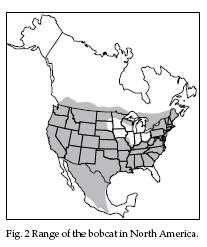 Range
and Habitat Range
and Habitat
The bobcat occurs in a
wide variety of habitats from the Atlantic to the
Pacific ocean and from Mexico to northern British
Columbia (Fig. 2). It occurs in the 48 contiguous
states. The bobcat is as adapted to subtropical forests
as it is to dense shrub and hardwood cover in temperate
climates. Other habitats include chaparral, wooded
streams, river bottoms, canyon-lands, and coniferous
forests to 9,000 feet (2,743 m). Bobcats prefer areas
where these native habitat types are interspersed with
agriculture and escape cover (rocky outcrops) close by.
The bobcat has thrived where agriculture is interspersed
through the above native habitat types, as in southern
Canada. Food Habits Bobcats are capable of hunting and
killing prey that range from the size of a mouse to that
of a deer. Rabbits, tree squirrels, ground squirrels,
woodrats, porcupines, pocket gophers, and ground hogs
comprise most of their diet. Opossums, raccoon, grouse,
wild turkey, and other ground-nesting birds are also
eaten. Occasionally, insects and reptiles can be part of
the bobcat’s diet. In Canada, the snowshoe hare is the
bobcat’s favorite fare. Bobcats occasionally kill
livestock. They also resort to scavenging.
General Biology, Reproduction, and Behavior
Bobcats are secretive,
shy, solitary, and seldom seen in the wild. They are
active during the day but prefer twilight, dawn, or
night hours. Bobcats tend to travel well-worn animal
trails, logging roads, and other paths. They use their
acute vision and hearing for locating enemies and prey.
Bobcats do not form lasting pair bonds. Mating can occur
between most adult animals. In Wyoming, female bobcats
reach sexual maturity within their first year but males
are not sexually mature until their second year.
Nationwide, breeding can occur from January to June. In
Wyoming, breeding typically begins in February and the
first estrus cycle in mid- March. The gestation period
in bobcats ranges from 50 to 70 days, averaging 62 days.
Nationwide, young are born
from March to July, with litters as late as October. The
breeding season may be affected by latitude, altitude,
and longitude, as well as by characteristics of each
bobcat population. In Wyoming, births peak mid-May to
mid-June and can occur as late as August or September.
These late litters may be from recycling or late-cycling
females, probably yearlings. In Utah, births may peak in
April or May. In Arkansas, births may peak as early as
March. Bobcats weigh about 2/3 pound (300 g) at birth.
Litters contain from 2 to 4 kittens. Kittens nurse for
about 60 days and may accompany their mother through
their first winter. Although young bobcats grow very
quickly Fig. 2 Range of the bobcat in North America.
C-37 during their first 6 months, males may not be fully
grown until 1 1/2 years and females until 2 years of
age. Bobcats may live for at least 12 years in the wild.
Bobcats reach densities of
about 1 per 1/4 square mile (0.7 km2) on some of the
Gulf Coast islands of the southeastern United States.
Densities vary from about 1 per 1/2 square mile (1.3
km2) in the coastal plains to about 1 cat per 4 square
miles (10.7 km2) in portions of the Appalachian
foothills. Mid-Atlantic and midwestern states usually
have scarce populations of bobcats. The social
organization and home range of bobcats can vary with
climate, habitat type, availability of food, and
predators. Bobcats are typically territorial and will
maintain the same territories throughout their lives.
One study showed home ranges in south Texas to be as
small as 5/8 square mile (1.0 km2). Another study showed
that individual bobcats in southeastern Idaho maintain
home ranges from 2.5 square miles to 42.5 square miles
(6.5 km2 to 108 km2) during a year. Females and
yearlings with newly established territories tend to
have smaller and more exclusive ranges than males.
Females also tend to use all parts of their range more
intensively than adult males.
Bobcats commonly move 1 to
4 miles (2 to 7 km2) each day. One study found that
bobcats in Wyoming moved from 3 to 7.5 miles (5 to 12
km) each day. Transient animals can move much greater
distances; for example, a juvenile in one study moved 99
miles (158 km). Adult bobcats are usually found
separately except during the breeding season. Kittens
may be seen with their mothers in late summer through
winter. An Idaho study found adult bobcats and kittens
in den sites during periods of extreme cold and snow.
Females with kittens less than 4 months old generally
avoid adult males because they kill kittens.
In Canada and the western
United States, bobcat population levels tend to follow
prey densities. Some biologists believe that coyote
predation restricts bobcat numbers. Unfortunately, not
enough is known about the relative importance of factors
such as litter size, kitten survival, adult sex ratios,
and survival rates to predict changes in local bobcat
populations. Also, relatively low densities and variable
trapping success hinder researchers from easily
predicting changes in populations.
Since the late 1970s,
state game agencies have been tagging bobcat pelts
harvested in their states. Information from these pelts
is being used to estimate bobcat population trends and
factors that contribute to those changes.
Damage and Damage Identification
Bobcats are opportunistic
predators, feeding on poultry, sheep, goats, house cats,
small dogs, exotic birds and game animals, and, rarely,
calves. Bobcats can easily kill domestic and wild
turkeys, usually by climbing into their night roosts. In
some areas, bobcats can prevent the successful
introduction and establishment of wild turkeys or can
deplete existing populations. Bobcats leave a variety of
sign. Bobcat tracks are about 2 to 3 inches (5 to 8 cm)
in diameter and resemble those of a large house cat.
Their walking stride length between tracks is about 7
inches (18 cm).
Carcasses of bobcat kills
are often distinguishable from those of cougar, coyote,
or fox. Bobcats leave claw marks on the backs or
shoulders of adult deer or antelope. On large carcasses,
bobcats usually open an area just behind the ribs and
begin feeding on the viscera. Sometimes feeding starts
at the neck, shoulders, or hindquarters. Bobcats and
cougar leave clean-cut edges of tissue or bone while
coyotes leave ragged edges where they feed. Bobcats bite
the skull, neck, or throat of small prey like lambs,
kids, or fawns, and leave claw marks on their sides,
back, and shoulders. A single bite to the throat, just
behind the victim’s jaws, leaves canine teeth marks 3/4
to 1 inch (2 to 2.5 cm) apart. Carcasses that are
rabbit-size or smaller may be entirely consumed at one
feeding. Bobcats may return several times to feed on
large carcasses.
Bobcats, like cougars,
often attempt to cover unconsumed remains of kills by
scratching leaves, dirt, or snow over them. Bobcats
reach out about 15 inches (38 cm) in raking up debris to
cover their kills, while cougars may reach out 24 inches
(61 cm). Bobcats also leave signs at den sites. Young
kittens attempt to cover their feces at their dens.
Females with young kittens may mark prominent points
around den sites with their feces. Adult bobcats leave
conspicuous feces along frequently traveled rocky ridges
or other trails. These are sometimes used as territorial
markings at boundaries.
Adult bobcats also mark
trails or cave entrances with urine. This is sprayed on
rocks, bushes, or snow banks. Bobcats may leave claw
marks at urine or feces scent posts by scraping with
their hind feet. These marks are 10 to 12 inches (25 to
30 cm) long by 1/2 inch (1.25 cm) wide. Bobcats also
occasionally squirt a pasty substance from their anal
glands to mark areas. The color of this substance is
white to light yellow in young bobcats but is darker in
older bobcats.
Legal Status
Among midwestern states,
the bobcat is protected in Iowa, Illinois, Indiana,
Ohio, and in most counties of Kentucky. It is managed as
a furbearer or game animal in the plains states. Western
states generally exempt depredating bobcats from
protected status. They can usually be killed by
landowners or their agent. In the more eastern states
and states where bobcats are totally protected, permits
are required from the state wildlife agency to destroy
bobcats. Consult with your state wildlife agency
regarding local regulations and restrictions.
Damage
Prevention and Control Methods
Exclusion
Use woven-wire enclosures to discourage bobcats from
entering poultry and small animal pens at night. Bobcats
can climb, so wooden fence posts or structures that give
the bobcat footing may not be effective. Bobcats also
have the ability to jump fences 6 feet (1.8 m) or more
in height. Use woven wire overhead if necessary. Fences
are seldom totally effective except in very small
enclosures.
Cultural Methods
Bobcats prefer areas with sufficient brush, timber,
rocks, and other cover, and normally do not move far
from these areas. Keep brush cut or sprayed around
ranches and farmsteads to eliminate routes of connecting
vegetation from bobcat habitat to potential predation
sites.
Frightening
Use night lighting with white flashing lights, or
bright continuous lighting, to repel bobcats. You can
also use blaring music, barking dogs, or changes in
familiar structures to temporarily discourage bobcats.
Repellents, Fumigants,
and Toxicants
No chemical repellents, fumigants, or toxicants are
currently registered for bobcats. Commercial house cat
repellents might be effective in some very unusual
circumstances. A hindrance to development of toxicants
is the bobcat’s preference to feed on fresh kills.
Trapping
Bobcats are more easily trapped than are coyotes or
foxes, but the bobcat’s reclusiveness makes set
locations difficult to find. When hunting, bobcats use
their sense of smell less than coyotes do, so lures and
baits are usually not effective. The bobcat’s acute
vision, hearing, and inquisitiveness however, can be
capitalized upon. Even with the best sets, bobcats
cannot be lured from their course of travel more than a
few yards (m). The bobcat’s use of dense cover for
capturing rodents and rabbits can be used in capture
techniques to guide the animal or even its footsteps. In
the past, the demand for bobcat pelts was moderately
high due to fur values. This had encouraged late fall
and winter harvest periods. Also, the bobcat’s high fur
quality attracts harvest for recreation or utility. If
bobcat depredations are common over time, consider
inviting a fur trapper to take bobcats during prime fur
periods. Fewer bobcats may result in less competition
for native foods and less depredation. Fur trappers may
undertake the capture and relocation of bobcats during
spring and summer months from areas where depredations
are occurring in return for fur trapping rights during
fall and winter months. Many of the same sets used for
foxes and coyotes will also catch bobcats. Few sets that
target bobcats will catch other predators. Bobcats can
be led by guide sticks or brush to dirt hole or flat
sets where proper lures are used.
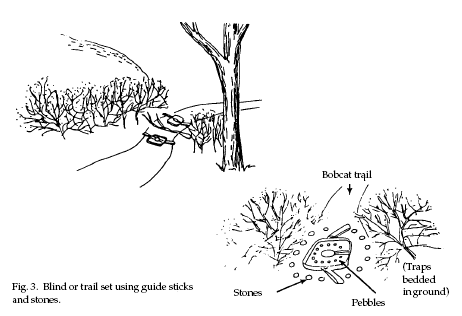 Leghold
Traps. Steel leghold traps, Nos. 2, 3, and 4 are
commonly used to capture bobcats. Trap size selection
depends on the area and weather conditions. For
coarse-textured sandy soils, use a No. 2 coilspring
trap. Use a No. 3 trap for wet or fine-textured clay
soils. Use No. 4 traps for frozen soils or in deep snow
sets. A bobcat is easy to hold, but sometimes more power
and jaw spread is required than a No. 2 coilspring
provides. The bobcat’s foot may be too large for proper
foot placement and a good catch. Guide sticks and stones
can be used (Fig. 3). Leghold
Traps. Steel leghold traps, Nos. 2, 3, and 4 are
commonly used to capture bobcats. Trap size selection
depends on the area and weather conditions. For
coarse-textured sandy soils, use a No. 2 coilspring
trap. Use a No. 3 trap for wet or fine-textured clay
soils. Use No. 4 traps for frozen soils or in deep snow
sets. A bobcat is easy to hold, but sometimes more power
and jaw spread is required than a No. 2 coilspring
provides. The bobcat’s foot may be too large for proper
foot placement and a good catch. Guide sticks and stones
can be used (Fig. 3).
Bobcats prefer fresh baits
such as rabbit, muskrat, or poultry. Scattered bits of
fur and feathers work well. Bobcats can be drawn to
traps by “flags” hung from trees or rocks located near
trap sets (Fig. 4). Suspend flags about 4 feet (1.3 m)
above the
 
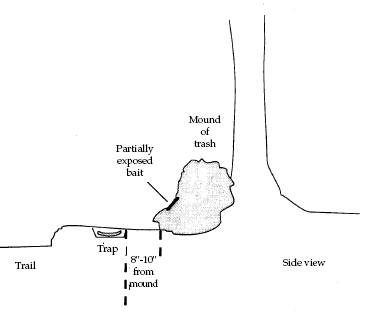 ground
with fine wire or string. A combination of stiff wire
with string attached to its end prevents entangling in
tree branches. Where animal parts are illegal, aluminum
foil or jar lids or imitation fur can be used. Location
is the key to trapping bobcats. If the location is not
correct, no flags or baits will work. A flag set uses a
piece of fur or a couple of feathers suspended about 4
feet (120 cm) above ground with fine wire or string.
Build a small mound of soil under the flag 1 foot (30
cm) high and 2 feet (60 cm) in diameter. Bobcats step
onto these mounds to reach the flag. Bury steel leghold
traps in the Fig. 3. Blind or trail set using guide
sticks and stones. Bobcat trail Stones Pebbles (Traps
bedded in ground) C-39 Fig. 5. Trash or scat mound set.
mound. Steel leghold traps can also be used in other
sets. See instructions in the Mountain Lions chapter.
Trash or mound sets take advantage of bobcats covering
their scat and leftover food (Fig. 5). This set is very
common. Pull up a pile of trash or litter over a large
bait, to mimic bobcat behavior. A smaller mound can be
made with urine poured over the trash. These sets are
useful where exposed baits are illegal. Both sets should
be used where backing such as rocks or trees are
available. Place a steel leghold trap and guide sticks
in front of trash pile sets. ground
with fine wire or string. A combination of stiff wire
with string attached to its end prevents entangling in
tree branches. Where animal parts are illegal, aluminum
foil or jar lids or imitation fur can be used. Location
is the key to trapping bobcats. If the location is not
correct, no flags or baits will work. A flag set uses a
piece of fur or a couple of feathers suspended about 4
feet (120 cm) above ground with fine wire or string.
Build a small mound of soil under the flag 1 foot (30
cm) high and 2 feet (60 cm) in diameter. Bobcats step
onto these mounds to reach the flag. Bury steel leghold
traps in the Fig. 3. Blind or trail set using guide
sticks and stones. Bobcat trail Stones Pebbles (Traps
bedded in ground) C-39 Fig. 5. Trash or scat mound set.
mound. Steel leghold traps can also be used in other
sets. See instructions in the Mountain Lions chapter.
Trash or mound sets take advantage of bobcats covering
their scat and leftover food (Fig. 5). This set is very
common. Pull up a pile of trash or litter over a large
bait, to mimic bobcat behavior. A smaller mound can be
made with urine poured over the trash. These sets are
useful where exposed baits are illegal. Both sets should
be used where backing such as rocks or trees are
available. Place a steel leghold trap and guide sticks
in front of trash pile sets.
Body-gripping Traps.
Bodygripping traps are very effective killer traps for
eliminating bobcats. These kill traps are spring-loaded.
When the trigger is released, the trap closes on the
animal in a scissors-like action. An example of this
type of trap is the Victor ® No. 330 Conibear®. This
trap, and others like it, can be very dangerous to use,
breaking arms, or killing large dogs if improperly set.
Check local regulations to determine if they are legal
to use in your area. For bobcats, set these traps in
trails at the base of a cliff or in brush. Use bait or
lures beyond the trap to entice the bobcat to walk
through it. Strategic bait placement also keeps bobcats
preoccupied. These sets can be made in dense cover in
trails, at the entrances to dens, or at gaps in fences
or brush where bobcats travel. These traps can also be
set in entrances to cubbies constructed to trap bobcats.
Place an attractive bait at the rear of the cubby and
place the kill trap so that the bobcat must go through
it to reach the bait. See Mountain Lions for other sets
made with body-gripping traps. Specific instructions on
trapping bobcats are found in Boddicker (1980).
Extensive bobcat trapping methods can also be found in
Weiland (1976), Young (1941), Johnson (1979), and
Musgrave and Blair (1979). Check all local and state
laws for using traps, snares, baits, or lures.
Wire Cage Traps.
Wire Cage Traps. Very large cage traps, made of wire
mesh or metal, when properly set, are effective.
Commercial traps from 15 x 15 x 40 inches (38 x 38 x 100
cm) up to 24 x 24 x 48 inches (60 x 60 x 120 cm) are
available. See the Supplies and Materials chapter. Use
brush or grass on the top and sides of the cage to give
the appearance of a natural “cubby” or recess in a rock
outcrop or brush. Traps should be set in the vicinity of
depredations, travelways to and from bobcat cover,
hunting sites. Cover the cage bottom with soil. Bait the
cage with poultry, rabbit, or muskrat carcasses, or live
animals. Check local and state laws for restrictions.
Snares. Snares are
very effective for bobcats but require expertise and
caution. When properly set, a snare can be used to
either kill or restrain a bobcat. Snares can be placed
in the same locations and situations as body-gripping
traps. They are particularly effective in cubby sets,
bobcat runways, and den entrances (Fig. 6). Properly
placed, snares offer the advantages of bodygripping
traps without the danger to pets and non-target
wildlife.
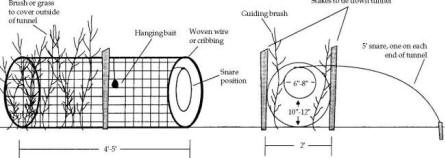 Fig.
6 Cubby set with snare Fig.
6 Cubby set with snare
 Fig.7.
Trail set with snare Fig.7.
Trail set with snare
Set snares in trails where
bobcats are known to travel (Fig. 7). Baits and lures
are usually not used with snares and may hinder success.
Use camouflage only to break up some of the outline of
the snare, preferably with native material, like
grasses. Do not tie camouflage material to the loop of
the snare. Spring-loaded snares work best. Put “memory”
into the snare by placing tension on the inside of the
lock against the cable with your finger as you close the
snare once or twice. This prevents a bobcat from walking
through a snare. Cables respond to the memory by closing
easily.
Kill snares actually kill
the captured bobcat and are most often used during the
furbearer season or for animals for which relocation has
failed (Fig. 8). They are best made from fine steel
cable, 1/16 inch (0.15 cm) or 5/64 inch (0.2 cm) in
diameter. Positive locks work well. Set kill snares with
the bottom of the loop about 10 to 12 inches (25 to 30
cm) off the ground with a loop 6 to 8 inches (15 to 20
cm) in diameter. This loop must be set perpendicular to
the trail.

Live snare sets capture and hold bobcats alive. They
differ from kill snare sets by their cable size, locks,
and entanglement precautions. Larger cables and relaxed
locks on live snare sets can reduce injury if set
properly. Relaxed locks tighten onto animals but relax
as the animal stops struggling. This allows the animal
to breath normally and regain composure.
Kill snares may be tied
off to a 3-inch (7.5-cm) diameter tree or larger . To
aid quick kills, hammer 2-foot (60-cm) stakes into the
ground, leaving 6 to 8 inches (15 to 20 cm) aboveground.
Killsnare locks (Gregerson, Camlock, Thompson, Keflock)
are in several of the supply catalogs listed in Supplies
and Materials.
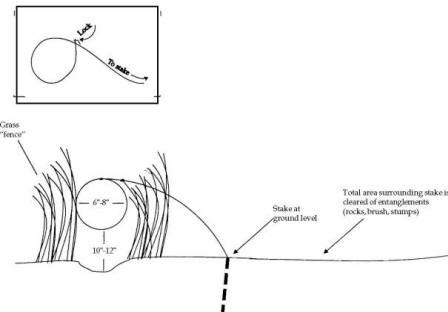
The live snare set (Fig. 9 at left) requires more
expertise than the kill snare set. Also, capture and
transport of bobcats is very dangerous. Use 3/32-inch
(0.25-cm) steel cable 6 to 8 feet (1.9 to 2.5 m) long.
Use snares with high quality swivels located midway or
closer to the loop. Stake live snares to the ground with
steel stakes, hammered to just below ground level. Use
loop sizes as in the kill snare set. Clear brush and
other entanglements from the area.
Use extreme caution when
releasing a snared animal. Catch poles with adjustable
steel nooses, thick leather gloves or gauntlets, and
other protective clothing are necessary. Immobilizing
drugs such as ketamine hydrochloride should be
accessible. Two people should handle captures; one at
the neck and the other at the back feet to remove the
snare. Cut a 1/2- x 4-inch (1.2- x 10-cm) slot from the
bottom up toward the center of a 3- x 3-foot (1- x 1-m),
5/8-inch (1.6-cm) or larger piece of plywood. A handle
should be attached at the upper end. Place the plywood
between you and the snared animal and let the cable run
through the slot as you approach, keeping the cable
tight. Check live snare sets frequently to avoid
unnecessary stress and loss of captured bobcats to
predators, such as eagles, coyotes, and mountain lions.
See Supplies and Materials for suppliers of bobcat
snares. Always ask for expert advice before attempting
live captures. Extensive instructions on snaring can be
found in Grawe (1981) and Krause (1981).
Shooting
Bobcats respond to predator calls at night and can
be shot. Use a red, blue, or amber lens with an 80,000-
to 200,000-candlepower (lumen) spotlight to locate
bobcats. Sources of predator calls are found in Supplies
and Materials. Dogs trained to track bobcats can be
useful in removing problem animals. Bobcats can be shot
after being treed. Bobcats may develop a time pattern in
their depredations on livestock or poultry. You can lie
in wait and ambush the bobcat as it comes in for the
kill. Rifles of .22 centerfire or larger, or shotguns
with 1 1/4 ounces (35 g) or more of No. 2 or larger shot
are recommended, since bobcats are rather large and
require considerable killing power.
Economics of Damage and Control
Damage by bobcats is
rather uncommon and statistics related to this damage
are not well developed. In western states where data
have been obtained, losses of sheep and goats have
comprised less than 10% of all predation losses. Typical
complaints of bobcat predation involve house cats and
poultry allowed to roam at will in mountain subdivisions
and ranches. Bobcats are taken by trappers and by
hunters using hounds. The pelts are used for coats,
trim, and accessories, the spotted belly fur being most
valuable. Bobcat pelts are used for wall decorations and
rugs. In recent years, North American bobcat harvests
have produced about 25,000 pelts valued at $2.5 million
annually. Aesthetically, the bobcat is a highly regarded
carnivore. To many people the bobcat represents the
essence of wildness in any habitat it occupies.
Acknowledgments
Thanks are due to Major
Boddicker, who authored this chapter in the 1983 edition
of this manual. The sections on identification, habitat,
food habits, general biology, and economics were adapted
from his work. Thanks also go to Bill Phillips, Arizona
Game and Fish Department, and Chuck McCullough, Nebraska
Game and Parks Commission, for their information. Figure
1 from Schwartz and Schwartz (1981). Figure 2 by Sheri
Bordeaux. Figures 3 through 6, 8 and 9 by Denny Hogeland,
adapted by Sheri Bordeaux. Figure 7 adapted from M. L.
Boddicker, 1980.
For
Additional Information
Bailey, T. N. 1974. Social
organization in a bobcat population. J. Wildl. Manage.
38:435-446.
Bailey, T. N. 1980.
Factors of bobcat social organization and some
management implications. Proc. Worldwide Furbearer Conf.
2:984-1000.
Blair, C. 1981. Predator
caller’s companion. Winchester Press, Tulsa, Oklahoma.
267 pp.
Blum, L. G., and P. C.
Escherich. 1979. Bobcat research conference proceedings,
current research on biology and management of Lynx rufus.
Natl. Wildl. Fed. Sci. Tech. Ser. 6 137 pp.
Boddicker, M. L., (ed.).
1980. Managing Rocky Mountain furbearers. Colorado
Trappers Assoc. LaPorte, Colorado. 176 pp.
Clark, T. W., and M. R.
Stromberg. 1987. Mammals in Wyoming. Univ. Kansas Museum
Nat. Hist. 319 pp.
Crowe, D. M. 1972. The
presence of annuli in bobcat tooth cementum layers. J.
Wildl. Manage. 36:1330-1332.
Crowe, D. M. 1975a. A
model for exploited bobcat populations in Wyoming. J.
Wildl. Manage. 39:408-415.
Crowe, D. M. 1975b.
Aspects of aging, growth, and reproduction of bobcats
from Wyoming. J. Mammal. 56:177-198.
Deems, E. F., and D.
Pursley, (eds.). 1983. North American furbearers — a
contemporary reference. Int. Assoc. Fish Wildl. Agencies
and Maryland Dep. Nat. Resour., Annapolis. 223 pp.
Fredrickson L. 1981.
Bobcat management. South Dakota Conserv. Digest
48:10-13.
Gluesing, E. A., S. D.
Miller, and R. M. Mitchell. 1986. Management of the
North American bobcat: information needs for
nondetrimental findings. Trans. N. A. Wildl. Nat. Resour.
Conf. 51:183-192.
Grawe, A. 1981. Grawe’s
snaring methods. Wahpeton, North Dakota. 48 pp.
Johnson, C. 1979. The
bobcat trappers bible. Spearman Publ. Sutton, Nebraska.
32 pp.
Karpowitz, J. F., and J.
T. Flinders. 1979. Bobcat research in Utah—a progress
report. Natl. Wildl. Fed. Sci. Tech. Ser. 6:70-73
Koehler, G. 1987. The
bobcat. Pages 399-409 in R. L. De Silvestro, ed. Audubon
Wildlife Report 1987. Natl. Audubon Soc., New York.
Krause, T. 1981. Dynamite
snares and snaring. Spearman Pub., Sutton, Nebraska. 80
pp.
McCord, C. M., and L. E.
Cardoza. 1982. Bobcat and lynx. Pages 728-768 in J. A.
Chapman and G. A. Feldhamer, eds. Wild mammals of North
America: biology, management, and economics. The Johns
Hopkins Univ. Press, Baltimore, Maryland. Musgrave, B.,
and C. Blair. 1979. Fur trapping. Winchester Press,
Tulsa, Oklahoma. 246 pp.
Robinson, W. B. 1953.
Population trends of predators and fur animals in 1080
station areas. J. Mammal. 34:220-227.
Rue, L. 1981. Furbearing
animals of North America. Crown Pub., New York. 343 pp.
Sampson, F. W. 1967.
Missouri bobcats. Missouri Conserv. 28:7.
Schwartz, C. W., and E. R.
Schwartz. 1981. The wild mammals of Missouri, rev. ed.
Univ. Missouri Press, Columbia. 356 pp.
Scott, J. 1977. On the
track of the lynx. Colorado Outdoors 26:1-3.
Wassmer, D. A., D. D.
Guenther, and J. N. Layn. 1988. Ecology of the bobcat in
south-central Florida. Bulls. Florida St. Museum, Biol.
Sci. 33:159-228.
Weiland, G. 1976. Long
liner cat trapping. Garold Weiland, Pub. Glenham, South
Dakota. 25 pp.
Young, S. P. 1941. Hints
on bobcat trapping. US Fish Wildl. Serv. Circ. No. 1, US
Govt. Print. Off., Washington, DC. 6 pp.
Young, S. P. 1958. The
bobcat of North America. Stackpole Co., Harrisburg,
Pennsylvania. 193 pp.
Editors
Scott E. Hygnstrom Robert
M. Timm Gary E. Larson
PREVENTION AND CONTROL OF
WILDLIFE DAMAGE — 1994 Cooperative Extension Division
Institute of Agriculture and Natural Resources
University of Nebraska - Lincoln United States
Department of Agriculture Animal and Plant Health
Inspection Service Animal Damage Control Great Plains
Agricultural Council Wildlife Committee
01/12/2007
Special
thanks to:
Clemson University
|